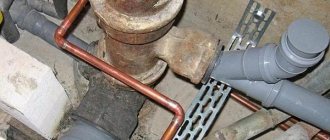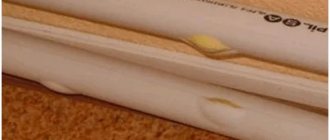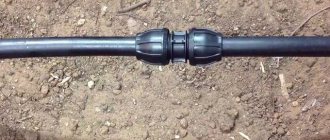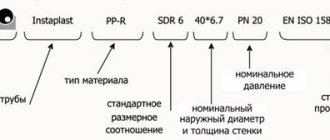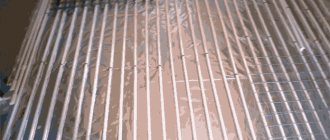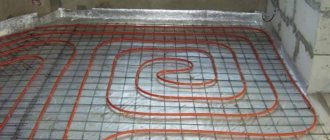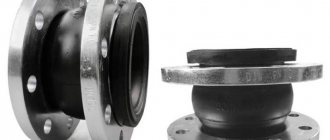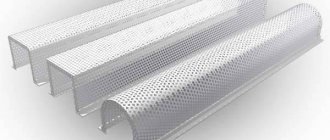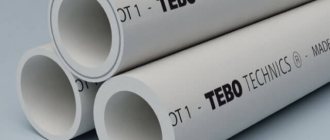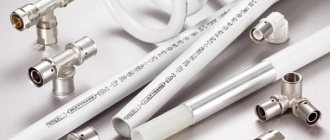Which to choose
Compensators must ensure a reduction in loads occurring in the longitudinal and transverse directions, as well as at an angle to the axis of the pipeline when removing the pipe.
L-shaped, U-shaped, ring compensators and snake-shaped devices are sections of a pipeline (made of the same polypropylene, or similar in characteristics, but with greater elasticity and elasticity of materials), which are given the appropriate shape.
They are mounted in the same way as sections of the main highway (how many layers of FUM tape need to be wound is written here).
Fittings are included in the design to obtain the shape (for example, for U-shaped expansion joints) or the desired characteristics are achieved without using them.
The range of devices that compensate for thermal expansion using other materials is much wider.
These include:
- axial bellows compensators KSO and surge arrester.
These devices are designed to compensate for pipe deformation in a direction coinciding with its axis.
An elastic structure is used as a working element - a bellows made of corrugated sanitary rubber or thin stainless steel.
Practical note! Devices of the surge arrester type are characterized by ease of installation due to the presence in the design of fastening units that serve as supports during pipeline installation;
- shear compensators KS. The devices are designed to compensate for deformations in a direction that does not coincide with the pipe axis, and, accordingly, have degrees of freedom in both (vertical and horizontal) planes.
The design of expansion joints includes one or two corrugated bellows.
When using a two-part device, the reliability of the connection of the bellows is achieved through the use of connecting reinforcement;
- rotary compensators KSP. The function of these devices is to compensate for the linear expansion of both sections of the pipe at the turning points of the pipeline.
They are used where, according to the laying conditions, the angle of rotation of the pipeline must remain unchanged;
- universal compensators KSU.
The devices allow you to compensate for all types of pipeline deviations that occur due to thermal expansion.
Accordingly, the working stroke of these devices is designed for axial, transverse and angular deviations.
The design features of these devices dictate their use on short sections of highways or in places where the use of other types of bellows compensating devices, for some reason, is limited or impossible;
- rubber bellows elements KR (flange). These compensators are used to compensate for the deviation of the axis of pipelines.
In addition, the devices act as dampers and are capable of absorbing water hammer in the serviced section of the highway.
In addition to their functional purpose, compensators are divided according to the installation method.
For polypropylene pipelines, welded and flanged expansion joints are used.
The welding method uses a traditional installation method for polypropylene pipes using welding equipment (which tool is needed is written here).
This connection method imposes mandatory conditions for the selection of compensators:
- identical diameter,
- wall thickness,
- internal section of the compensating device and pipeline section.
Installation of the compensating device is carried out by connecting the flanges on the compensator and the pipeline.
The advantage of this method is to obtain a detachable connection that is easy to maintain and repair.
The main disadvantage is the increased complexity of installation and a greater number of technological operations.
Attention! Installing a metal flange on a polypropylene pipeline is not an easy task. Therefore, it is better to entrust its implementation to specialists with relevant experience.
Therefore, it is better to entrust its implementation to specialists with relevant experience.
For your information! Under certain conditions, the use of bellows expansion joints, in addition to combating thermal expansion, solves the problem of eliminating eddy fluid flows in the pipeline, which increases the safety of its operation.
Effective operation of compensating devices is possible only if the rules for their installation are observed.
Sources
- https://trubanet.ru/truby-dlya-otopleniya/kompensatory-dlya-polipropilenovykh-trub-silfonnye-p-obraznye-kompensator-kozlova.html
- https://HomeBuild2.ru/truby/kompensator-dlya-polipropilenovih.html
- https://ru-canalizator.com/santehnika/s-oborudovanie/kompensator.html
Advantages and disadvantages
This part takes on the most important function for any pipeline - ensuring structural integrity. This makes her indispensable. The product is good because:
- Effectively helps stabilize internal pressure on pipes;
- Produces cutoff of so-called vortex flows;
- Promotes quick and convenient fastening (welding) with the main main pipe;
- It has a high degree of reliability due to its manufacture from high-quality materials;
- It has a very long working life and service life exceeding 50 years;
- When installed correctly, it ensures perfect tightness.
No significant deficiencies in the design, structure or operation of these products have been identified. The only, and perhaps the most significant disadvantage is the possibility of combination only with those pipes that are made of polypropylene.
Types and differences
Today, several main types of expansion joints are produced that are mounted on polypropylene water supply:
Loop compensator
- Bellows axial products of the KSO and OPN brands. Installation and subsequent integration of such products is extremely simple and straightforward. This is due to the presence of special fastening guide units. They are presented in the form of firmly fixed supports, which greatly simplifies their installation.
- Shift compensators brand KSS. Designed to effectively provide compensation in two areas simultaneously. They are located parallel to the central axis of the highway. In addition, the design is equipped with one or two corrugations, which are made of stainless steel. The elements are connected to each other by means of connecting fittings.
- Rotating elements of the PCB. They are used to eliminate the consequences of linear expansion. It occurs on those sections of the pipeline where there are bends. The device rigidly fixes the angle and can follow the contours of the highway at an angle of 90 degrees.
- Universal types of KSU products. They have three operating stroke modes - angular, transverse and axial. Often, such an element is used in cases where it is necessary to install a short main line with a large number of branches.
- Rubber flanged bellows expansion joints are actively being introduced into the structure of those water pipelines where water hammer often occurs. These devices can compensate for minor inaccuracies associated with the curvature of the central axis of the water main.
How to choose?
Before you purchase a compensator, there are a few important guidelines to consider.
First of all, before purchasing, you need to correctly take into account the diameter of the product itself and the diameter of the pipe on which it will be mounted.
These indicators must match. It must be remembered that the most common diameter of plastic pipes is from 20 to 40 mm. For systems located in apartments and private houses, the most acceptable diameter is 20 mm.
The heating system cannot be installed without compensators
Remember that using the flange mounting method, the compensator is attached not to the line, but to the counter flange.
Based on this, preference is given to a flange compensator. This product will provide a reliable, sealed, and at the same time detachable connection.
In the event that an emergency occurs, it will be possible to quickly replace the element immediately.
Due to the simplicity of the design, the price of the expansion joint for polypropylene pipes is quite reasonable. It fluctuates within the following limits.
Bellows compensator, KSO:
- Working pressure: 16 atm;
- Total length: 250 mm;
- Pipe diameter: 21.5 mm;
- Price: 3-4 $.
Shear compensator, KSS:
- Working pressure: 12 atm;
- Total length: 170 mm;
- Pipe diameter: 18 mm;
- Price: 2-3 $.
Flange compensator, rubber:
- Working pressure: 18 atm;
- Total length: 295 mm;
- Pipe diameter: 20 mm;
- Price: 1-2.5 $.
Bellows expansion joint for polypropylene pipes
The bellows expansion joint for polypropylene pipes is a shock-absorbing and compensating element for mechanical or thermal changes in the polypropylene pipeline system.
Working stroke: 70mm (55mm in compression and 15mm in tension) Bellows: multilayer bellows and internal screen are made of stainless steel 08Х10Н11Т.
Application area:
- Heating piping of tall buildings
- Hot and cold water supply systems
- Vertical pipe connections.
Design features of the compensator for polypropylene pipes
The polypropylene bellows compensator is produced in the “EJMA” version and complies with temperature and pressure standards according to DIN 2401. The outer screen of the compensator is made of aluminum.
The nominal diameter of the pipes for the operation of this compensator can be from 15mm (1/2″) to 50mm (2″). The operating pressure must not exceed 16 bar. The temperature range within which normal operation of the compensator for polypropylene pipes is possible is +100°C. This compensator is designed for 1000 full cycles.
Specifications and prices
The table below presents the technical specifications for bellows expansion joints for polypropylene pipes, the price is indicated in dollars.
| Connection diameter. | Dn, mm. | D1, mm. | D2, mm. | L, mm. | L1,mm. | Price, $ |
| 1/2” | 15 | 38 | 35 | 390 | 15 | 33,00 |
| 3/4” | 20 | 38 | 35 | 390 | 15 | 33,00 |
| 1” | 25 | 48 | 44 | 440 | 15 | 52,00 |
| 1 1/4” | 32 | 60 | 54 | 490 | 20 | 65,50 |
| 1 1/2” | 40 | 75 | 69 | 470 | 20 | 85,50 |
| 2” | 50 | 75 | 69 | 470 | 20 | 87,50 |
Why is thermal expansion dangerous?
Thermal expansion of polypropylene pipes is considered one of the negative factors that must be taken into account when designing and installing systems.
Its danger is illustrated by the following figures.
For material reinforced with glass fiber, the figure is 0.06 mm/deg., for material reinforced with aluminum - 0.03 mm/deg.
With a temperature difference of 60 degrees, the elongation of 1 meter of unreinforced pipe will be about 9 mm.
Such a temperature difference is not impossible.
An example of conditions leading to such a situation is the design and assembly of a heating system at an air temperature of 20 degrees and the supply of coolant heated to 80 degrees to the pipes (the standard water temperature in hot water supply pipes is indicated on this page).
If a straight section of heating pipe passes through 2 adjacent rooms with a wall length of 5 m, its total length is 10 m.
In such a section, the total elongation under the described conditions will reach 90 mm.
If there are insufficient gaps between the pipeline and the walls (and in the described case they should be at least 45 mm), the pipe will rest against the structure.
This will lead to deformation forces that threaten the integrity of both the fittings and the pipe walls.
Creating the necessary gaps (almost 5 cm from the walls) violates the aesthetics of the system and the interior of the premises.
Important conclusion! Deformation of pipes due to thermal expansion leads to a violation of the tightness of the connections.
Due to additional mechanical loads, it poses a danger to the integrity of pipeline sections and connected equipment.
Compensators are used to compensate for thermal expansion.
Dependence of the structure of the material on the influence of temperature
It is necessary to distinguish the maximum temperature that PP pipes can withstand from their actual physical properties. Despite the fact that the manufacturer indicates the melting point of polypropylene at 170 °C, in fact, polypropylene products begin to soften already at 135-140 °C.
We recommend that you read: Is it possible to wall up polypropylene pipes when laying a pipeline into a wall?
Installing such pipes without taking into account thermal expansion is not just a risk of deformation. The consequences of errors in the design of engineering systems can be significant:
- fastening elements break down;
- air accumulates in the deformed area, reducing the throughput of the system (so-called airing);
- the temperature of radiators and risers decreases, the system operates less efficiently;
- pipes burst and coolant leaks occur.
Important! For installation of engineering systems, unreinforced and reinforced PP pipes are used. The latter have an additional layer that protects the outer layer of the polymer from overheating. Due to this, the coefficient of thermal expansion of the pipe is reduced, but it is not completely leveled.
Reinforced polypropylene pipes have a lower CTE, but it still needs to be taken into account.
Average coefficient of thermal expansion:
- unreinforced – 0.15 mm/mK;
- metal reinforced – 0.03 mm/mK;
- glass fiber reinforced - 0.035 mm/mK.
In fact, the coefficient of thermal expansion for unreinforced PP pipes of 0.15 mm looks like an extension of the section by 1 cm for each meter of pipeline if the temperature of the working medium reaches 70°C.
Attention! This does not mean that a 5 m long pipe will lengthen by 5 cm when hot water is turned on. In hot water supply systems, the water temperature is a maximum of 65°C, therefore the expansion coefficient will also be lower.
But, ultimately, when calculating the length of the engineering system, real temperature indicators must be taken into account. For a heating system, the length of the pipe can increase by 5 cm or more.
Design features of compensators
In order to reduce the risk of pipe bursts during operation, during the assembly of the water supply system, it is necessary to consider the installation location of the polypropylene compensator. Such a compensator is made in the form of a loop; its inclusion in the system makes it possible to compensate for the linear expansion or contraction of pipes, thereby increasing the safety and service life of the pipeline.
And a little more about the design, the compensator “loop” is quite easily mounted into the pipeline system due to its simple shape and low weight. Experienced specialists choose the middle of the pipe to install expansion joints, placing it between supports that are motionless and, in turn, segment the pipe. No special tools are required for installation, nor additional sealing agents.
For polypropylene pipes, a bellows axial compensator can also be used, made in the form of a corrugated insert that compresses or expands during changes in temperature or water pressure.
The advantage of using expansion joints
Connecting compensating devices of the type: PP (for polypropylene pipes) are used in cold and hot water supply systems, as well as when laying heating. Such devices are found both in dachas and in houses in residential areas; in addition, they cannot do without compensators and pipelines of large office buildings and industrial premises. Thus, we can highlight several clear advantages of protecting polypropylene pipes using expansion joints:
- The first is ease of installation and comparative cheapness of the material;
- Increasing the service life of the system, by the way, the service life of polypropylene pipes, with proper assembly, reaches 50 years;
- The pressure in the pipes is distributed evenly, and eddy flows are also cut off;
- The pipeline can be vertical or horizontal; this circumstance will not interfere with protecting the pipes from kinks, elongation and water breakthrough at the joints.
Bellows expansion joints are installed on a straight section. They can accept extensions that were originally included in the project. Before installation, possible deviations must be checked to ensure that all technical characteristics comply with those specified in the project. In addition, you need to make sure that there is no damage to the compensator. Only one compensator can be placed between the fixed supports. Welding is used to connect the device to the pipeline.
Features of plastic pipelines
Among which:
- the operating pressure for pipes made of this material is up to 10 atmospheres (it may be necessary to test the pipelines for strength and tightness);
- The upper limit of the operating temperature range exceeds 90 degrees. This is enough for wiring hot water supply and heating systems;
- the material is absolutely not subject to corrosion, inert to most chemicals used in everyday life, and is not biodegradable;
- the surface quality of polypropylene pipes and the properties of the material prevent the deposition of plaque, including limescale, on the walls;
- the service life of polyethylene pipelines is at least 30-50 years;
- polypropylene is absolutely safe for human health and does not release toxic compounds into water or air;
- this polymer is fireproof.
The installation technology involves the use of welding (iron for soldering polypropylene pipes) to obtain reliable connections.
If you have the appropriate equipment, anyone can master the skills of installing systems made of polypropylene pipes.
Among the disadvantages of polypropylene pipes, experts note the inability to give them the required shape.
Due to this, turns of highways are performed exclusively using fittings.
Another serious disadvantage of this polymer is its high coefficient of thermal expansion.
Thanks to it, polypropylene pipes are characterized by significant elongation and/or sagging when transporting hot media (hot water or coolant of heating systems), and at high outside temperatures.
Installation taking into account the linear expansion rate
When installing a pipeline for hot water supply and heating (including underfloor heating systems), it is necessary to take into account the elongation of the pipe as a result of exposure to high temperatures.
The optimal choice of products for pipeline installation is reinforced pipes with a fiberglass or aluminum inner layer. Reinforcement - a layer of foil or fiberglass - absorbs part of the thermal energy from the coolant and reduces the coefficient of thermal expansion of the polymer. Thanks to this, the need to compensate for physical changes will also be reduced.
Rules for installing pipes taking into account linear expansion:
- It is necessary to leave a small gap between the pipeline and the wall in the room, because pipes can deviate from their axis when heated and move in waves;
- It is especially important to leave small gaps in the corners of rooms where pipes are connected by rotary couplings or flanges;
- on long sections of the pipeline, special linear expansion compensators are installed, which simultaneously fix the pipeline in its plane, but allow it to move in the direction of installation;
- It is desirable to reduce the number of rigid joints to provide flexibility to the pipeline.
In some hot water supply and heating systems based on reinforced and non-reinforced products, you can see various methods of the so-called. self-compensation of thermal expansion due to elastic deformation of polypropylene.
Most often, loop-shaped compensating sections are used - circular turns with movable fixation on the wall. The loop resulting from such an installation contracts and expands when the coolant heats up/cools, without affecting the position and geometry of the pipeline in other sections.
We recommend that you read: How to properly install a chimney for a modern fireplace?
Pipe expansion compensators
In addition to self-compensation, pipe deformation as a result of thermal expansion can be prevented using additional devices - mechanical compensators. They are installed on L- and U-shaped sections of pipelines and represent sliding supports through which the pipe passes.
Special expansion compensators are divided into several types:
- Axial (bellows) - devices in the form of two flanges, between which there is a spring that compensates for the compression and expansion of the pipeline section. They are fixedly attached to the support.
- Shear - used to compensate for the axial deviation of a pipeline section during thermal expansion.
- Rotary – installed on turning areas of the highway to reduce deformation.
- Universal - combine expansion in all directions, compensating for rotation, shift and compression of the pipe.
Kozlov compensator
There is also a new type of device, named after its developer - the Kozlov compensator. This is a more compact device that looks like a section of polypropylene pipeline.
Inside the compensator there is a spring that absorbs the energy of expansion of pipes within the area, compressing when the water heats up and expanding when cooling. The advantage of the Kozlov compensator over other types of devices is easier and simpler installation, as well as reduced consumption of fittings.
Unlike a loop-shaped section, when installing a Kozlov compensator, it is enough to connect a section of pipes using a flanged or welded method.
What is it needed for
When installing pipeline systems, a natural question may certainly arise: why do you need a compensator for polypropylene pipelines?
The polypropylene expansion joint is presented in the form of a special connecting type design. It often has the shape of a loop.
The purpose of the polypropylene compensator is to provide compensation for the linear expansion of the pipeline. The device prevents excessive exposure of the internal walls of the pipeline to factors such as high temperature and excessive pressure.
Thus, installing expansion joints on polypropylene pipes ensures optimal stabilization of the entire aquifer.
Despite the fairly low cost and relative simplicity of design, this device significantly increases the service life of pipelines.
The compensator, due to the simplicity of its design, allows installation on almost any straight section of pipelines. It ensures a high degree of reliability of the entire system.
Design Features
Loop expansion joints for polypropylene pipelines are often made using static polypropylene.
Modern products are manufactured using a special injection molding method. Often this part is sold in two color variations - white and gray.
The polypropylene compensator, due to the simplicity of its design and relatively low weight, can be easily installed on a water supply system.
PVC pipe connection
Correct installation of this product does not require the use of special tools or seals.
Thermal compensators for polypropylene pipes are widely used in all types of pipelines.
By installing this product, you thereby significantly increase its strength and protection against ruptures.
This is especially true for those places where joints and junctions are located. Often a compensator for polypropylene is mounted in the middle of the pipe. This may be an area located between two fixed supports.
In addition, expansion joints effectively protect the pipeline from excessive stretching or sudden displacement.
This can happen when the temperature of the working medium inside the pipe rises sharply, or when a water hammer occurs.
The device is widely used for a number of systems. This:
- systems and pipelines for cold water supply;
- systems providing hot water where expansion is unavoidable;
- heating systems.
It effectively fulfills its restrictive function in cases of unauthorized reduction of pipes made of polypropylene.
The device is mounted on the highways of buildings with various purposes. It can be:
- Country and multi-apartment residential buildings;
- Commercial and administrative buildings;
- All types of industrial premises.
Varieties
In practice, the following varieties have proven themselves to be the best:
Bellows expansion joints for polypropylene (PPR). They are used when installing heating and water supply networks made of PPR materials. The nominal diameter of bellows types is from 1.5 to 5 cm. The connection type of bellows varieties is coupling, and the casing is made of aluminum. Their internal screen is made of stainless steel. Working environment temperature up to one hundred and fifteen degrees, pressure up to 16 bar. The working medium for the bellows version is drinking water, air, steam.
Shear. They are designed to compensate for movement in two directions. Design features in this situation are one or two bellows corrugations. It is made from stainless steel and secured with fittings-connectors.
Rotary. They are used to level the linear increase in the area of the turn of the highway and serve to fix the turn. Most often they are taken to change the direction of the system by ninety degrees.
- Universal. They are equipped with three options for working strokes. They are placed where it is necessary to lay a short network, or in a place limited for installing a bellows type.
- Flanged. These rubber parts are placed in a place where there is a need to dampen the shock wave from a sharp increase in the average operating pressure. They also smooth out axial inaccuracies of the pipeline.
- Loop-shaped device.
- Coils
- Axial bellows mechanisms
- Flange devices made of soft material
- Bellows
- Universal, which are effective for displacement in the axial, angular and transverse directions. They are recommended for installation on a small branch of a highway that has branches
Manufacturers offer various devices that are of excellent quality. But a self-made compensation loop in the heating system also copes well with the functions assigned to it.
It is not difficult to make such a device with your own hands. The compensation loop can be made in a short time. This important detail, fastened correctly, becomes a guarantee of flawless operation of heating or hot water supply.
Simple do-it-yourself equipment with a compensation loop will increase the working life of communication networks to half a century.
Calculations for U-shaped expansion joints
In Russia, parameters for U-shaped expansion joints are still not standardized. They are produced in accordance with the needs of the project and according to the data that is prescribed in this project (type, dimensions, diameter, material, etc.). But still, of course, you should not determine the dimensions of the U-shaped compensator at random. Special calculations will help you find out the dimensions of the compensator that will be sufficient to compensate for deformations of the heating main due to temperature changes.
In such calculations, as a rule, the following conditions are accepted:
• the pipeline is made of steel pipes;
• water or steam flows through it;
• the pressure inside the pipeline does not exceed 16 bar;
• working environment temperature no more than 2000 degrees Celsius
• compensators are symmetrical, the length of one arm is strictly equal to the length of the second arm;
• the pipeline is in a horizontal position;
• the pipeline is not affected by wind pressure or other loads.
As we can see, ideal conditions are taken here, which, of course, makes the final figures very conditional and approximate. But such calculations still make it possible to reduce the risk of damage to the pipeline during operation.
And one more important addition. When calculating changes in a pipeline under the influence of heat, the highest temperature of the transported water or steam is taken as the basis, and the ambient temperature, on the contrary, is set to the minimum.
How to choose the right device
To find out which compensating element is best installed on polypropylene, you need to understand in detail the design of these devices.
Polypropylene (PP) piping is installed very often. With its help, they equip the supply of hot water, where the temperature rises to almost one hundred degrees. During use, polypropylene has exhibited a number of characteristics that make it ideal for plumbing and heating systems. It is not afraid of the influence of aggressive chemical environments, is light in weight and is quite durable.
For this reason, it is recommended to install flexible expansion joints in areas longer than ten meters. They make it possible to reduce expansion from thermal effects.
To select and install it correctly, you need to take into account the diameter. It must match the diameter of the pipeline itself. Most often, the diameter of the compensation element is from 20 to 40 mm. For a house or apartment, a device of 20 millimeters will be sufficient.
As for the manufacturer, it is better to give preference to well-known global brands. They present high-quality products for polypropylene networks, which are successfully used in many areas.
Important additional information
Thermal insulation
PVC pipes
Some thermal insulation products can be destructive to thermoplastic pipes. It is recommended to insulate using the following materials (only some options are shown in the list):
- Mineral felt
- Armaflex class 1 NT
- Penofenoplast
- Polystyrene.
Some types of foam rubber and adhesives can be toxic when used together with foam rubber. Therefore, it is not recommended to use them as a means of fastening thermal insulation of a pipeline. Adhesives should only be used for bonding purposes.
Pipeline heating
Thermoplastic piping can be damaged by the plasticizers used in the outer coating of some electric heating tapes. Tapes with a plasticized PVC sheath should not be used. (This comment also applies to any tapes, adhesives, or other substances used to attach electric heating tape elements to the pipeline.) Recommended electric heating elements—Tape heaters with a silicone rubber, woven wire mesh, or woven polyester sheath will minimize the risk of plasticizer interaction with pipeline material. Therefore, it is preferable to use these tapes on thermoplastic systems.
PVC-U pipeline marking
Do not place adhesive labels directly on the surface of the pipe as the adhesive may damage the outer surface of the pipe. It is recommended to use a spacer material such as aluminum foil between the pipe and the identification tag.
Foaming mastics and sealants
Certain sealants contain phthalates. Phthalates are extremely aggressive to PVC-based materials, therefore, before using any sealants and mastics for PVC pipes, it is necessary to obtain confirmation that the selected sealant matches the chemical composition of the unplasticized PVC pipeline.
Clamps for fastening PVC pipes
It is important that the staples and their coating do not contain substances that could have a destructive effect on the unplasticized PVC pipe. Check selected products for compatibility with pipe material
We recommend using Cobra clamps for pipes up to and including 160 mm outside diameter/6 inch nominal inside diameter.
Freezing conditions
Care must be taken to prevent the contents of the pipeline from freezing, as this may cause the pipe to burst.
Contact of uPVC with various fluxes
Some fluxes can be destructive to unplasticized PVC piping
Special precautions should be taken when soldering copper piping directly above or near unplasticized PVC piping
Thread sealants
Some thread sealants may damage unplasticized PVC piping. It is recommended to use Teflon tape for threaded connections.
Resistance of unplasticized PVC to ultraviolet rays
Protection from ultraviolet rays such as sunlight should be provided, especially during storage. Exposure to them may cause discoloration and deterioration of the material. And, although these are only superficial changes, it is nevertheless recommended to avoid exposure to ultraviolet radiation. When storing outdoors, pipes should be covered with opaque material. When installed outdoors, PVC pipes are recommended to be protected from ultraviolet rays by insulation or painting.
Underground pipeline
It is prohibited to lay the pipeline in contaminated soil. It is prohibited to lay the pipeline in soil where liquid chemicals are released.
UPVC pipes and pressure surges
A pipeline made of unplasticized PVC is able to withstand pressure surges within the designated limits. Under no circumstances should pressure surges exceed the continuous operating pressure shown in the chart.
Types of compensation devices
In practice, several main types of expansion joints for polypropylene pipes are actively used:
- In the form of a loop - it is the simplest.
- Coil or spiral.
- Axial bellows marked KSO or OPN.
- Flange type - allows you to soften water hammer, is made of soft material and is convenient to install.
- Bellows expansion joint for polypropylene pipes is a key device for containing linear expansion.
- Shear – allows you to restrain linear expansion in 2 planes. It consists of two sections of stainless corrugated pipe, connected by a special fastener.
- Rotary - used wherever the pipe bends at an angle of 90º.
- Universal - suitable for compensating shifts in the transverse, angular or axial section, especially on small sections of branched pipelines where other types of devices are not applicable.
All these devices are united by the fact that to obtain the desired effect, they must be mounted only on sections of flexible polypropylene pipeline.
It is very convenient to use compensators during the installation of rotating sections. Thanks to these devices, it is possible to extinguish liquid turbulence and stabilize the pressure in the pipeline.
Among the best foreign manufacturers of expansion joints for polypropylene pipes are Finnish companies, as well as the Turkish company Kayse. Among domestic suppliers one can note the company SanTermo.
Calculation of expansion coefficient for various types of pipes
There is a formula for calculating the expansion of polypropylene pipes when heated, which allows you to determine how much the length of the pipeline will increase:
D=k*DT*t, where
- D is the required length of the section after heating;
- k is the coefficient of thermal expansion;
- DT - design pipeline length in meters;
- t is the temperature difference between the air in the room and the coolant.
For example, to install a heating system 10 meters long and with a design coolant temperature of 90 °C, aluminum-reinforced polypropylene pipes will be used.
We recommend that you read: Replacing old pipes with polypropylene on your own
The temperature in the room during installation is 25 °C. Using the formula, you can determine the length of the section after heating: 0.03*(90-25)*10 = 19.5 mm.
That is, when designing a pipeline made of reinforced polypropylene with a length of 10 m, it is necessary to add a reserve length of 1.95 cm.
